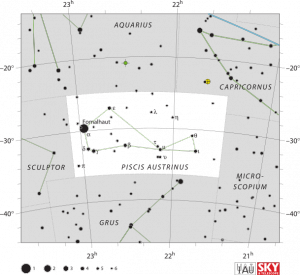by Dave Blane
Gamma Piscis Austrini (ϒ PsA) (22h 52m 32s -32d 52m 32s) is about one degree south-west of delta PsA which, in turn, is 3 degrees south of the first magnitude Fomalhaut. Delta (HWE91) is a fine, unequal pair found by Howe which is almost a twin of gamma which was thought to have been first seen as double by John Herschel whilst at the Cape of Good Hope in 1835 and has the discoverer code HJ5367.
In fact, Brian Warner, writing in the Monthly Notices of the Astronomical Society of Southern Africa in 1977 (Vol 36, page 134) makes a case for the duplicity of gamma PsA having been found by Fearon Fallows, the first Astronomer Royal at the Cape, a few years before.
Fallows used a Mural Circle and a Transit instrument and made a list of double stars which he had happened across during the course of routine observations.
Gamma is a very unequal system, magnitudes 4.5 and 8.2, with a companion which is slowly widening and is currently 4″ distant. The primary is an AO giant some 217 light years away although Hartung (using a 30-cm reflector) saw the colours as pale and deep yellow whilst Gould with 175-mm also from Australia called the primary `off-white’.
(Ref. Webb Deep Sky Society – Double Star Section)
Gamma PsA and delta PsA provide a challenge for users of 100mm and larger telescopes because of the big difference in brightness but steady observing conditions and high magnification will reward the diligent observer.
The table below is taken from the Washington Double Star Catalog and gives the position angles and separations of gamma PsA as well as delta PsA.
| RA (h m s) | Dec (d m s) | Disc code | PA | Sep | M1 | M2 |
| 22 52 31 | -32 52 32 | HJ 5367 | 256 | 4,1 | 4,5 | 8,2 |
| 22 55 57 | -32 32 23 | HWE 91 | 249 | 4.9 | 4,2 | 9.2 |
Finder chart for gamma Piscis Austrini

